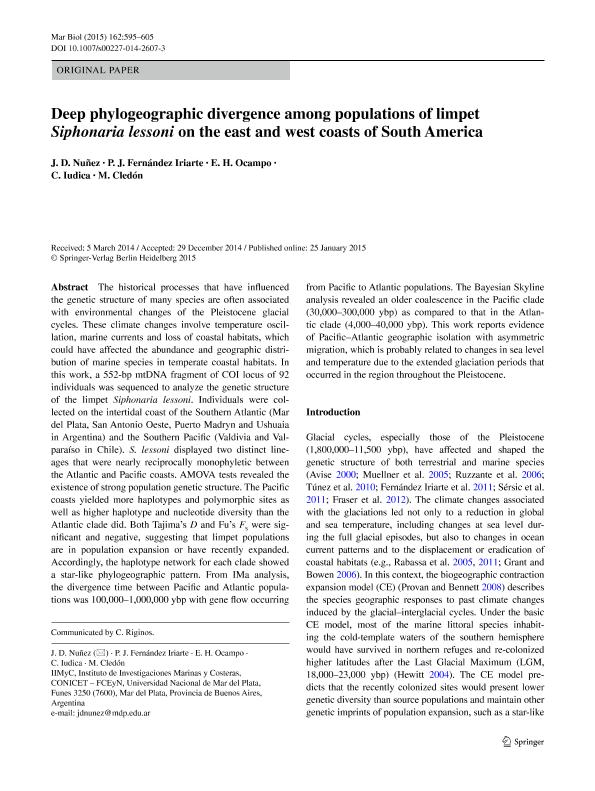Artículo
Deep phylogeographic divergence among populations of limpet Siphonaria lessoni on the east and west coasts of South America
Nuñez, Jesus Dario ; Fernandez Iriarte, Pedro Jose
; Fernandez Iriarte, Pedro Jose ; Ocampo, Emiliano Hernan
; Ocampo, Emiliano Hernan ; Iudica, Celia Estela; Cledón, Maximiliano
; Iudica, Celia Estela; Cledón, Maximiliano
 ; Fernandez Iriarte, Pedro Jose
; Fernandez Iriarte, Pedro Jose ; Ocampo, Emiliano Hernan
; Ocampo, Emiliano Hernan ; Iudica, Celia Estela; Cledón, Maximiliano
; Iudica, Celia Estela; Cledón, Maximiliano
Fecha de publicación:
01/2015
Editorial:
Springer
Revista:
Marine Biology
ISSN:
0025-3162
Idioma:
Inglés
Tipo de recurso:
Artículo publicado
Clasificación temática:
Resumen
The historical processes that have influenced the genetic structure of many species are often associated with environmental changes of the Pleistocene glacial cycles. These climate changes involve temperature oscillation, marine currents and loss of coastal habitats, which could have affected the abundance and geographic distribution of marine species in temperate coastal habitats. In this work, a 552-bp mtDNA fragment of COI locus of 92 individuals was sequenced to analyze the genetic structure of the limpet Siphonaria lessoni. Individuals were collected on the intertidal coast of the Southern Atlantic (Mar del Plata, San Antonio Oeste, Puerto Madryn and Ushuaia in Argentina) and the Southern Pacific (Valdivia and Valparaíso in Chile). S. lessoni displayed two distinct lineages that were nearly reciprocally monophyletic between the Atlantic and Pacific coasts. AMOVA tests revealed the existence of strong population genetic structure. The Pacific coasts yielded more haplotypes and polymorphic sites as well as higher haplotype and nucleotide diversity than the Atlantic clade did. Both Tajima’s D and Fu’s Fs were significant and negative, suggesting that limpet populations are in population expansion or have recently expanded. Accordingly, the haplotype network for each clade showed a star-like phylogeographic pattern. From IMa analysis, the divergence time between Pacific and Atlantic populations was 100,000–1,000,000 ybp with gene flow occurring from Pacific to Atlantic populations. The Bayesian Skyline analysis revealed an older coalescence in the Pacific clade (30,000–300,000 ybp) as compared to that in the Atlantic clade (4,000–40,000 ybp). This work reports evidence of Pacific–Atlantic geographic isolation with asymmetric migration, which is probably related to changes in sea level and temperature due to the extended glaciation periods that occurred in the region throughout the Pleistocene.
Palabras clave:
PHYLOGENETIC
,
LIMPETS
,
INTERTIDAL
,
INDIRECT DEVELOP
Archivos asociados
Licencia
Identificadores
Colecciones
Articulos(IIMYC)
Articulos de INSTITUTO DE INVESTIGACIONES MARINAS Y COSTERAS
Articulos de INSTITUTO DE INVESTIGACIONES MARINAS Y COSTERAS
Citación
Nuñez, Jesus Dario; Fernandez Iriarte, Pedro Jose; Ocampo, Emiliano Hernan; Iudica, Celia Estela; Cledón, Maximiliano; Deep phylogeographic divergence among populations of limpet Siphonaria lessoni on the east and west coasts of South America; Springer; Marine Biology; 162; 3; 1-2015; 595-605
Compartir
Altmétricas



